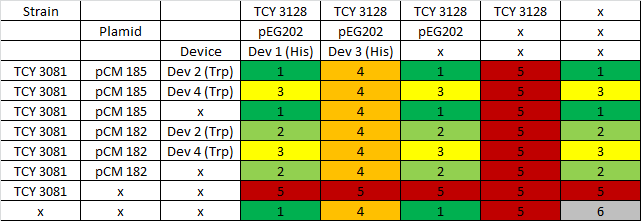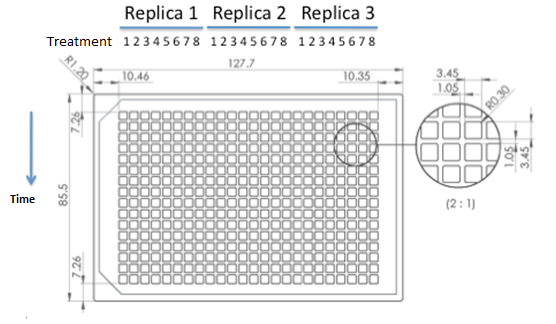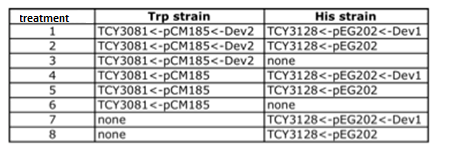Team:Buenos Aires/Results/BBsTesting
From 2012.igem.org
(→Coculture of strains) |
(→Coculture of strains) |
||
| Line 42: | Line 42: | ||
Due to a time constrain, we ordered the experiments by level of priority and proceeded to test our devices by cocultures 1 and 2. | Due to a time constrain, we ordered the experiments by level of priority and proceeded to test our devices by cocultures 1 and 2. | ||
| - | Starters of each strain were done in medium complementary to the auxotrophy of the strain so that they would maintain their plamids (medium –H for pEG202; medium –T for pCM182/5 and medium SC for cells without plasmid), then sonicated briefly in low power and then washed with medium –H-T . When they are in exponential phase, we set the coculture of strains was at OD 600: 0.04 (Total | + | Starters of each strain were done in medium complementary to the auxotrophy of the strain so that they would maintain their plamids (medium –H for pEG202; medium –T for pCM182/5 and medium SC for cells without plasmid), then sonicated briefly in low power and then washed with medium –H-T . When they are in exponential phase, we set the coculture of strains was at OD 600: 0.04 (Total, 1:1), in 5 ml of medium –H-T and we added ampicillin in order to avoid contaminations. |
We used epifluorescence microscope in order to determinate the strain proportion of each coculture. We used a 384 wells plate , with 20 Ul of cyclohexamide 2x (CHX 2x) in each of the wells where we placed a sample. The density of the culture was calculated based on the cell density at in each wells. | We used epifluorescence microscope in order to determinate the strain proportion of each coculture. We used a 384 wells plate , with 20 Ul of cyclohexamide 2x (CHX 2x) in each of the wells where we placed a sample. The density of the culture was calculated based on the cell density at in each wells. | ||
Revision as of 01:57, 24 October 2012

PARA AGREGAR RESULTADOS DEL TESTEO DE LOS DEVICES
Contents |
Secretion Rate of Trp as a function of culture growth
The aim of this experiment is to characterize the function of Trp secreting devices 2 and 4. We cultured the transformed strains overnight in 5 ml of medium +H-T until they reached an OD: 0.1 (exponential phase).
In order to have a clear signal we used:
TCY3081 <- pCM185 <- Device 2 TCY3081 <- pCM185 <- Device 4 TCY3081 <- pCM185 TCY3081 <- pCM182 <- Device 2 TCY3081 <- pCM182 <- Device 4 TCY3081 <- pCM182 TCY3081
We did 3 replica of each culture. As from this point we measured OD every hour until they reached an OD: 0.8 (approximately). We then measured the Trp signal for each culture medium using the spectrophotometer.
Experimental determination of K death
In order to determinate the K death used in the modeling section of our wiki, we set cultures of the two auxotrophic strains without being transformed (TCY3081 and TCY3128) in medium –HT at an initial OD of 0.01.
Taking into account that an OD:1 is approximately 3.10 7 cells/ml, we plated X ml in order to have around 200 colonies in the first day. Each following day we plated x ml of the culture and counted the number of colonies obtain in each plate. We set 3 replica of each strain.
Coculture of strains
We proceeded then to test the coculture growth of transformed strains with devices vs transformed strains with empty devices and non transformed strains.

|
Table: Coculture planification. Number indicates level of priority of the experiment for characterization of devices.
Due to a time constrain, we ordered the experiments by level of priority and proceeded to test our devices by cocultures 1 and 2.
Starters of each strain were done in medium complementary to the auxotrophy of the strain so that they would maintain their plamids (medium –H for pEG202; medium –T for pCM182/5 and medium SC for cells without plasmid), then sonicated briefly in low power and then washed with medium –H-T . When they are in exponential phase, we set the coculture of strains was at OD 600: 0.04 (Total, 1:1), in 5 ml of medium –H-T and we added ampicillin in order to avoid contaminations.
We used epifluorescence microscope in order to determinate the strain proportion of each coculture. We used a 384 wells plate , with 20 Ul of cyclohexamide 2x (CHX 2x) in each of the wells where we placed a sample. The density of the culture was calculated based on the cell density at in each wells.

|
Graph: 384 wells plate to be used for epifluorescence microscope.

|
Table: Coculture planification for number 1.
 "
"